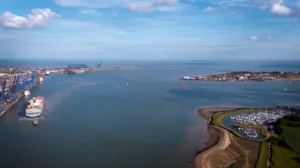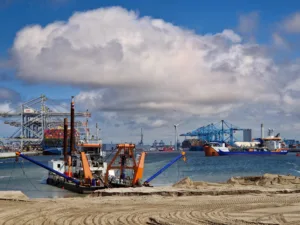Creating Islands in Arabian Sea
Nature Based Solutions (NBS) leverage natural processes and features, including ecosystem-based management approaches to address societal challenges and to provide engineering, economic, and environmental benefits (IUCN 2020). In the context of the port sector, NBS can involve measures that leverage natural systems and processes to enhance resilience, optimize infrastructure, and/or protect against environmental hazards and serve as carbon sink that help advance a country’s Paris Agreement Nationally Determined Contributions (NDCs).
 Credit;KONSBERG
Credit;KONSBERG
Coastal Erosions
Ecosystems such as mangroves and other wetlands can mitigate flooding, reefs can reduce the impact of waves and coastal erosion, and sediment management solutions or restoration of riverbanks and channels can influence dredging needs and/or cycles. Ports located in the Caribbean Sea, Indian Ocean, and Pacific Islands, are projected to be confronted with extremely high climate related risks by 2100.
Breakwater & Marine Life
Hard port structures such as breakwaters and quay walls are retrofitted or designed using specialised concrete units with surface complexity that encourages marine life to populate walls. Sandy foreshores can shelter vessels from waves and winds. They can be built instead of, or to reinforce, rubble mound breakwaters. Dunes on these foreshores offer storm protection and can be elevated to counter sea level rise and other increasing climate risks besides enhancing natural and aesthetic view.
Deltas & Estuaries
Tidal parks can be a solution along the riverine or estuarine embankments while benefiting habitat creation, biodiversity, and water quality for the purpose of “restoring estuarine ecosystems”.
 Credit;Van Ord
Credit;Van Ord
Dredging can Create Islands for Real Estate Development
Dredged sediment is invariably discarded in marine landfills on land or offshore, a practice that can increase GHG emissions and disrupt local ecosystems. However, sediment holds significant environ- mental, economic, and social value. Successful instance are Harwich Haven project (Save Mersea Harbour project) where dredged material was used to reclaim two islands for coastal protection and habitat creation signifying the practical benefits and feasibility of reusing dredged sediment through NBS projects . As the dredger and disposal location are already required for the dredging of a channel the major costs of this measure are mitigated due to the drainage and ground improvement of the new land reclaimed from dredged material. The coastline of Karachi depicts uneducated land reclamation whereas the natural and sustainable biodiversity model employs the utilisation of easily available dredged sediment in monsoon prone areas. In the Indus Delta region islands can be created from dredged sediment which will serve the purpose of conserving marine sanctuaries , preventing salt water intrusion into arable land, preventing storm surges, lowering logistical costs of ports in dumping of sediment and affordable coastal real estate development.
Author ; Nadir Mumtaz
Trademark Blue Economy IPO-PK

Credit:
World Bank Group
EcoShape
https://www.linkedin.com/company/ecoshape/posts/?feedView=all
https://openknowledge.worldbank.org/entities/publication/f6e6b4cb-74c0-4bef-ab5c-da6cc0bdbebe

Leave A Comment